Disneyland Paris: Business Strategy and Market Adaptation Report
VerifiedAdded on 2019/12/04
|11
|3348
|307
Report
AI Summary
This report provides a comprehensive analysis of Disneyland Paris's international business operations. It begins with an introduction to Disneyland Paris, highlighting its significance as a major entertainment destination. The report then delves into Task 1, exploring why France/Europe is an attractive market, analyzing key international business environmental factors through a PEST analysis (political, economic, social, and technological), and offering justified recommendations. Task 2 examines the strategies of local market adaptation versus standardization, detailing how Disneyland Paris balances both approaches. Task 3 focuses on the challenges faced by Disneyland's HR department and provides recommendations for Disney leaders. The report concludes with a summary of findings and recommendations, providing a strategic overview of Disneyland Paris's operations and future prospects. The report uses various models and principles to effectively investigate the ongoing functionalities of the Disneyland Paris enterprise.

Disneyland
Paraphrase This Document
Need a fresh take? Get an instant paraphrase of this document with our AI Paraphraser
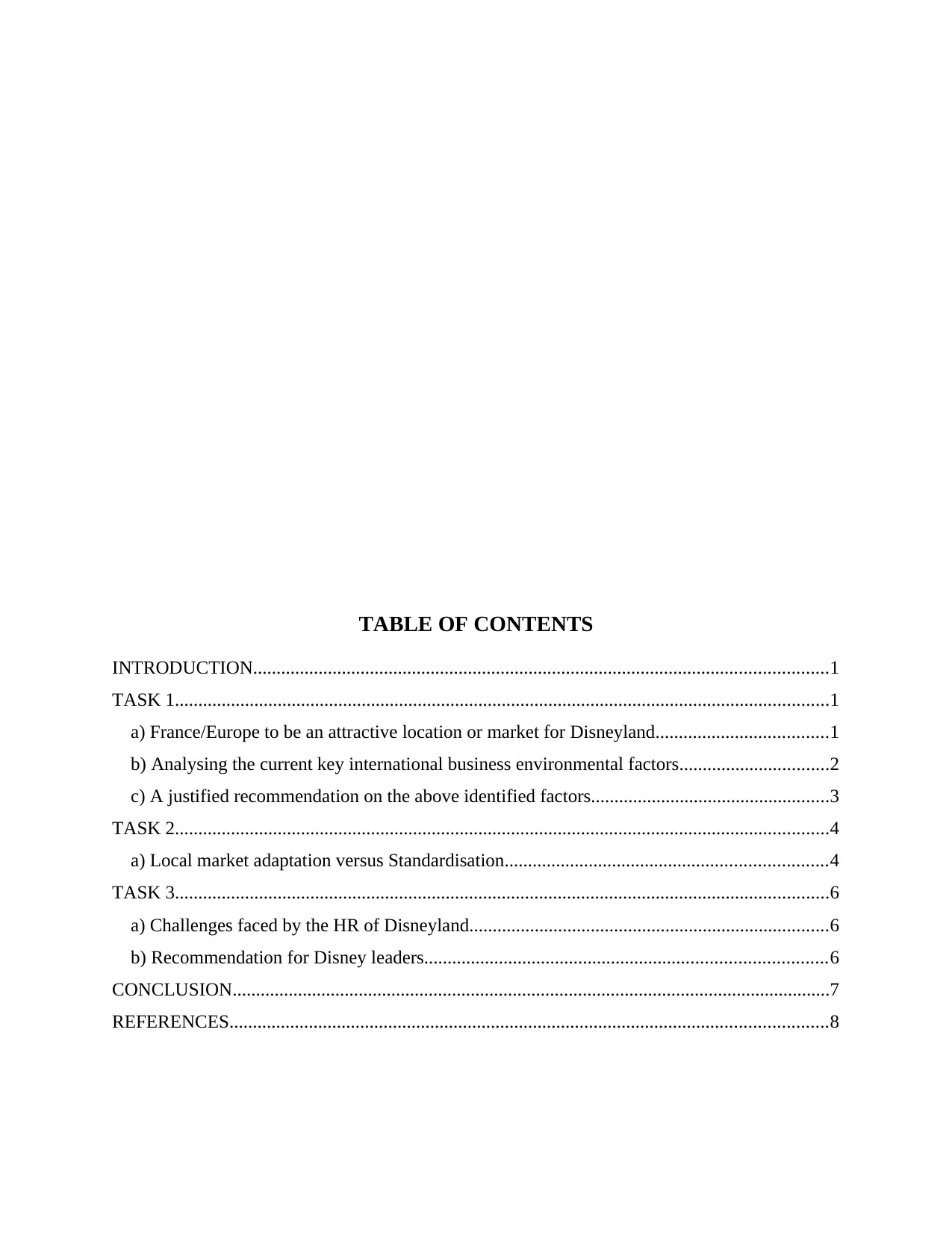
TABLE OF CONTENTS
INTRODUCTION...........................................................................................................................1
TASK 1............................................................................................................................................1
a) France/Europe to be an attractive location or market for Disneyland.....................................1
b) Analysing the current key international business environmental factors................................2
c) A justified recommendation on the above identified factors...................................................3
TASK 2............................................................................................................................................4
a) Local market adaptation versus Standardisation.....................................................................4
TASK 3............................................................................................................................................6
a) Challenges faced by the HR of Disneyland.............................................................................6
b) Recommendation for Disney leaders......................................................................................6
CONCLUSION................................................................................................................................7
REFERENCES................................................................................................................................8
INTRODUCTION...........................................................................................................................1
TASK 1............................................................................................................................................1
a) France/Europe to be an attractive location or market for Disneyland.....................................1
b) Analysing the current key international business environmental factors................................2
c) A justified recommendation on the above identified factors...................................................3
TASK 2............................................................................................................................................4
a) Local market adaptation versus Standardisation.....................................................................4
TASK 3............................................................................................................................................6
a) Challenges faced by the HR of Disneyland.............................................................................6
b) Recommendation for Disney leaders......................................................................................6
CONCLUSION................................................................................................................................7
REFERENCES................................................................................................................................8
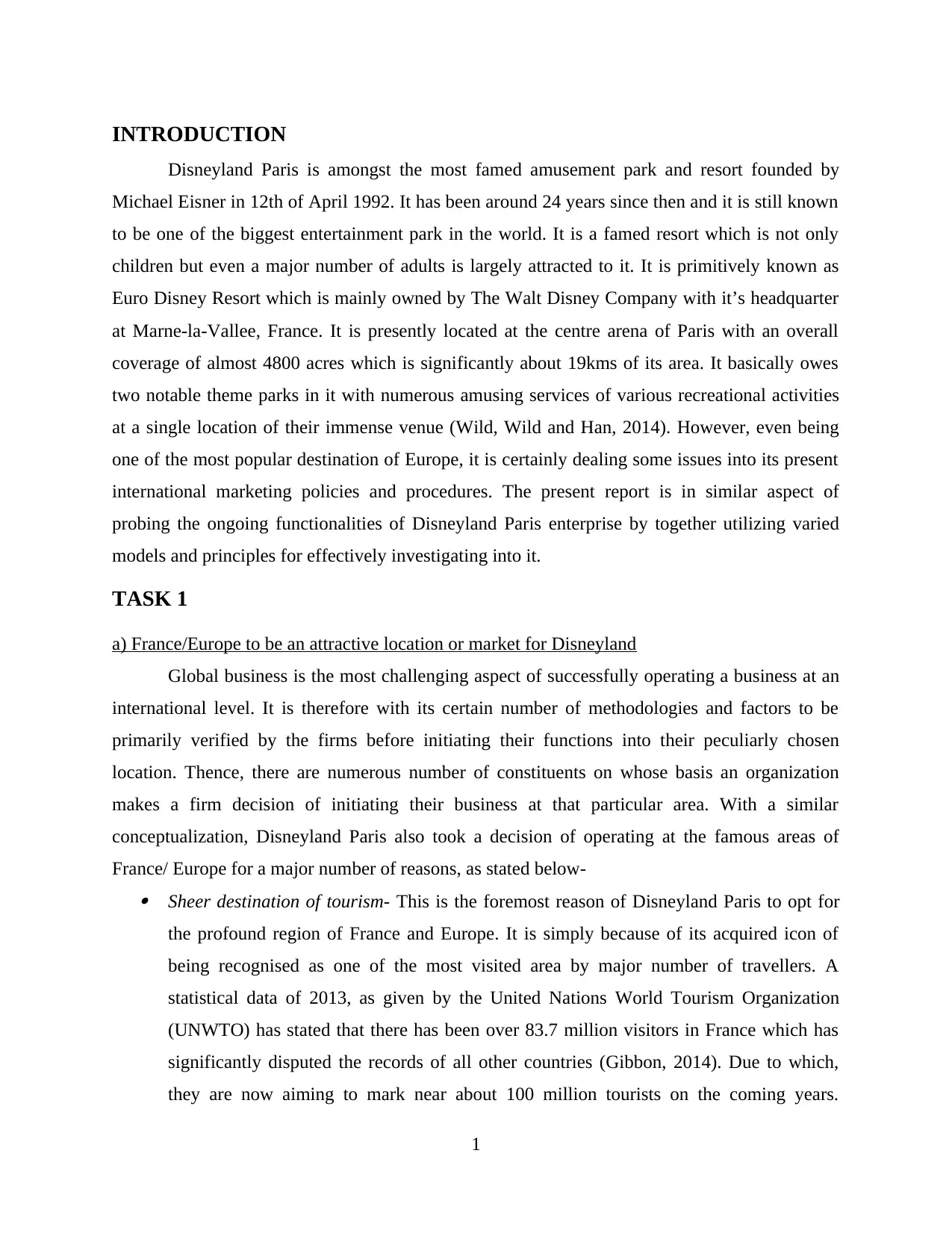
INTRODUCTION
Disneyland Paris is amongst the most famed amusement park and resort founded by
Michael Eisner in 12th of April 1992. It has been around 24 years since then and it is still known
to be one of the biggest entertainment park in the world. It is a famed resort which is not only
children but even a major number of adults is largely attracted to it. It is primitively known as
Euro Disney Resort which is mainly owned by The Walt Disney Company with it’s headquarter
at Marne-la-Vallee, France. It is presently located at the centre arena of Paris with an overall
coverage of almost 4800 acres which is significantly about 19kms of its area. It basically owes
two notable theme parks in it with numerous amusing services of various recreational activities
at a single location of their immense venue (Wild, Wild and Han, 2014). However, even being
one of the most popular destination of Europe, it is certainly dealing some issues into its present
international marketing policies and procedures. The present report is in similar aspect of
probing the ongoing functionalities of Disneyland Paris enterprise by together utilizing varied
models and principles for effectively investigating into it.
TASK 1
a) France/Europe to be an attractive location or market for Disneyland
Global business is the most challenging aspect of successfully operating a business at an
international level. It is therefore with its certain number of methodologies and factors to be
primarily verified by the firms before initiating their functions into their peculiarly chosen
location. Thence, there are numerous number of constituents on whose basis an organization
makes a firm decision of initiating their business at that particular area. With a similar
conceptualization, Disneyland Paris also took a decision of operating at the famous areas of
France/ Europe for a major number of reasons, as stated below- Sheer destination of tourism- This is the foremost reason of Disneyland Paris to opt for
the profound region of France and Europe. It is simply because of its acquired icon of
being recognised as one of the most visited area by major number of travellers. A
statistical data of 2013, as given by the United Nations World Tourism Organization
(UNWTO) has stated that there has been over 83.7 million visitors in France which has
significantly disputed the records of all other countries (Gibbon, 2014). Due to which,
they are now aiming to mark near about 100 million tourists on the coming years.
1
Disneyland Paris is amongst the most famed amusement park and resort founded by
Michael Eisner in 12th of April 1992. It has been around 24 years since then and it is still known
to be one of the biggest entertainment park in the world. It is a famed resort which is not only
children but even a major number of adults is largely attracted to it. It is primitively known as
Euro Disney Resort which is mainly owned by The Walt Disney Company with it’s headquarter
at Marne-la-Vallee, France. It is presently located at the centre arena of Paris with an overall
coverage of almost 4800 acres which is significantly about 19kms of its area. It basically owes
two notable theme parks in it with numerous amusing services of various recreational activities
at a single location of their immense venue (Wild, Wild and Han, 2014). However, even being
one of the most popular destination of Europe, it is certainly dealing some issues into its present
international marketing policies and procedures. The present report is in similar aspect of
probing the ongoing functionalities of Disneyland Paris enterprise by together utilizing varied
models and principles for effectively investigating into it.
TASK 1
a) France/Europe to be an attractive location or market for Disneyland
Global business is the most challenging aspect of successfully operating a business at an
international level. It is therefore with its certain number of methodologies and factors to be
primarily verified by the firms before initiating their functions into their peculiarly chosen
location. Thence, there are numerous number of constituents on whose basis an organization
makes a firm decision of initiating their business at that particular area. With a similar
conceptualization, Disneyland Paris also took a decision of operating at the famous areas of
France/ Europe for a major number of reasons, as stated below- Sheer destination of tourism- This is the foremost reason of Disneyland Paris to opt for
the profound region of France and Europe. It is simply because of its acquired icon of
being recognised as one of the most visited area by major number of travellers. A
statistical data of 2013, as given by the United Nations World Tourism Organization
(UNWTO) has stated that there has been over 83.7 million visitors in France which has
significantly disputed the records of all other countries (Gibbon, 2014). Due to which,
they are now aiming to mark near about 100 million tourists on the coming years.
1
⊘ This is a preview!⊘
Do you want full access?
Subscribe today to unlock all pages.

Trusted by 1+ million students worldwide
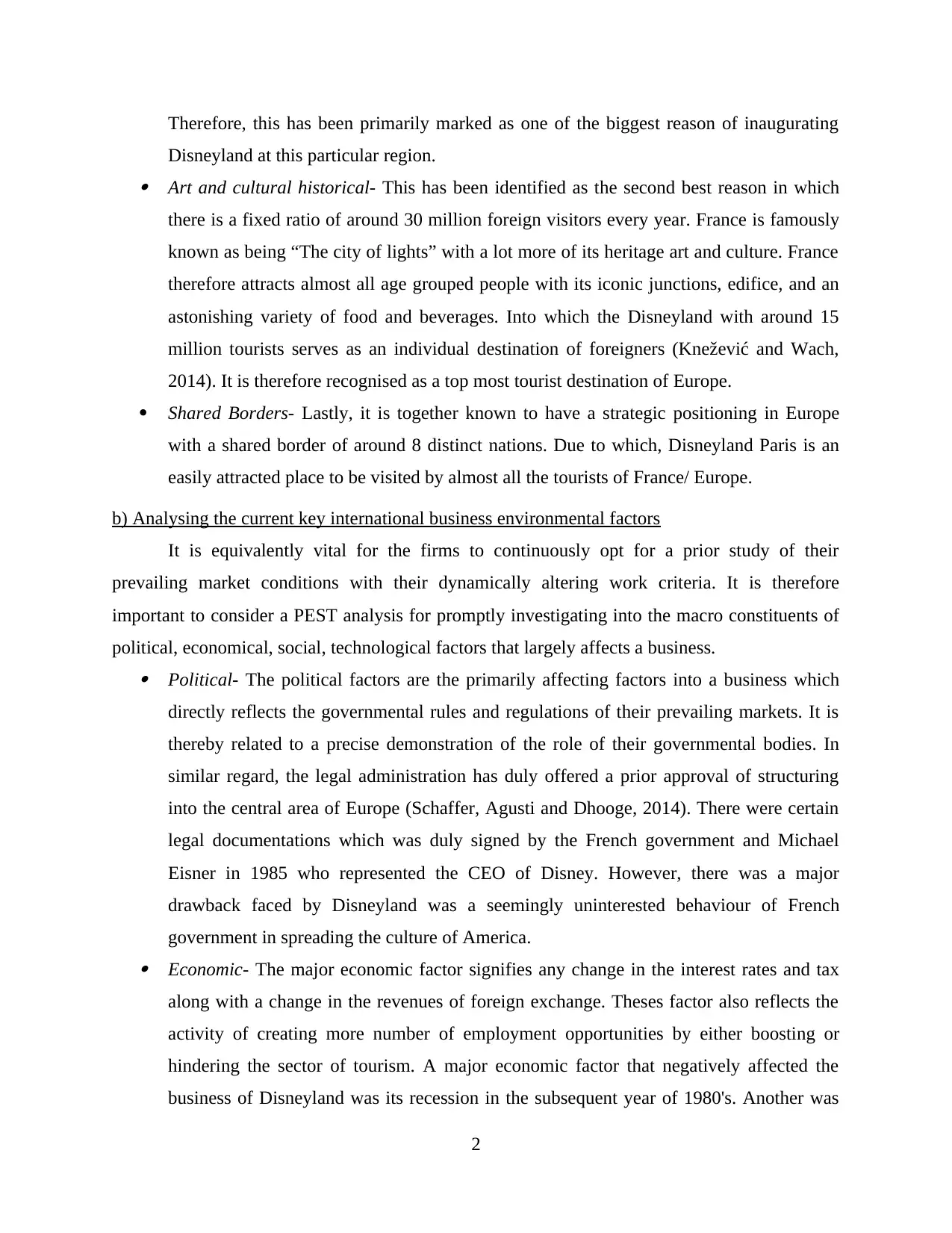
Therefore, this has been primarily marked as one of the biggest reason of inaugurating
Disneyland at this particular region. Art and cultural historical- This has been identified as the second best reason in which
there is a fixed ratio of around 30 million foreign visitors every year. France is famously
known as being “The city of lights” with a lot more of its heritage art and culture. France
therefore attracts almost all age grouped people with its iconic junctions, edifice, and an
astonishing variety of food and beverages. Into which the Disneyland with around 15
million tourists serves as an individual destination of foreigners (Knežević and Wach,
2014). It is therefore recognised as a top most tourist destination of Europe.
Shared Borders- Lastly, it is together known to have a strategic positioning in Europe
with a shared border of around 8 distinct nations. Due to which, Disneyland Paris is an
easily attracted place to be visited by almost all the tourists of France/ Europe.
b) Analysing the current key international business environmental factors
It is equivalently vital for the firms to continuously opt for a prior study of their
prevailing market conditions with their dynamically altering work criteria. It is therefore
important to consider a PEST analysis for promptly investigating into the macro constituents of
political, economical, social, technological factors that largely affects a business. Political- The political factors are the primarily affecting factors into a business which
directly reflects the governmental rules and regulations of their prevailing markets. It is
thereby related to a precise demonstration of the role of their governmental bodies. In
similar regard, the legal administration has duly offered a prior approval of structuring
into the central area of Europe (Schaffer, Agusti and Dhooge, 2014). There were certain
legal documentations which was duly signed by the French government and Michael
Eisner in 1985 who represented the CEO of Disney. However, there was a major
drawback faced by Disneyland was a seemingly uninterested behaviour of French
government in spreading the culture of America. Economic- The major economic factor signifies any change in the interest rates and tax
along with a change in the revenues of foreign exchange. Theses factor also reflects the
activity of creating more number of employment opportunities by either boosting or
hindering the sector of tourism. A major economic factor that negatively affected the
business of Disneyland was its recession in the subsequent year of 1980's. Another was
2
Disneyland at this particular region. Art and cultural historical- This has been identified as the second best reason in which
there is a fixed ratio of around 30 million foreign visitors every year. France is famously
known as being “The city of lights” with a lot more of its heritage art and culture. France
therefore attracts almost all age grouped people with its iconic junctions, edifice, and an
astonishing variety of food and beverages. Into which the Disneyland with around 15
million tourists serves as an individual destination of foreigners (Knežević and Wach,
2014). It is therefore recognised as a top most tourist destination of Europe.
Shared Borders- Lastly, it is together known to have a strategic positioning in Europe
with a shared border of around 8 distinct nations. Due to which, Disneyland Paris is an
easily attracted place to be visited by almost all the tourists of France/ Europe.
b) Analysing the current key international business environmental factors
It is equivalently vital for the firms to continuously opt for a prior study of their
prevailing market conditions with their dynamically altering work criteria. It is therefore
important to consider a PEST analysis for promptly investigating into the macro constituents of
political, economical, social, technological factors that largely affects a business. Political- The political factors are the primarily affecting factors into a business which
directly reflects the governmental rules and regulations of their prevailing markets. It is
thereby related to a precise demonstration of the role of their governmental bodies. In
similar regard, the legal administration has duly offered a prior approval of structuring
into the central area of Europe (Schaffer, Agusti and Dhooge, 2014). There were certain
legal documentations which was duly signed by the French government and Michael
Eisner in 1985 who represented the CEO of Disney. However, there was a major
drawback faced by Disneyland was a seemingly uninterested behaviour of French
government in spreading the culture of America. Economic- The major economic factor signifies any change in the interest rates and tax
along with a change in the revenues of foreign exchange. Theses factor also reflects the
activity of creating more number of employment opportunities by either boosting or
hindering the sector of tourism. A major economic factor that negatively affected the
business of Disneyland was its recession in the subsequent year of 1980's. Another was
2
Paraphrase This Document
Need a fresh take? Get an instant paraphrase of this document with our AI Paraphraser
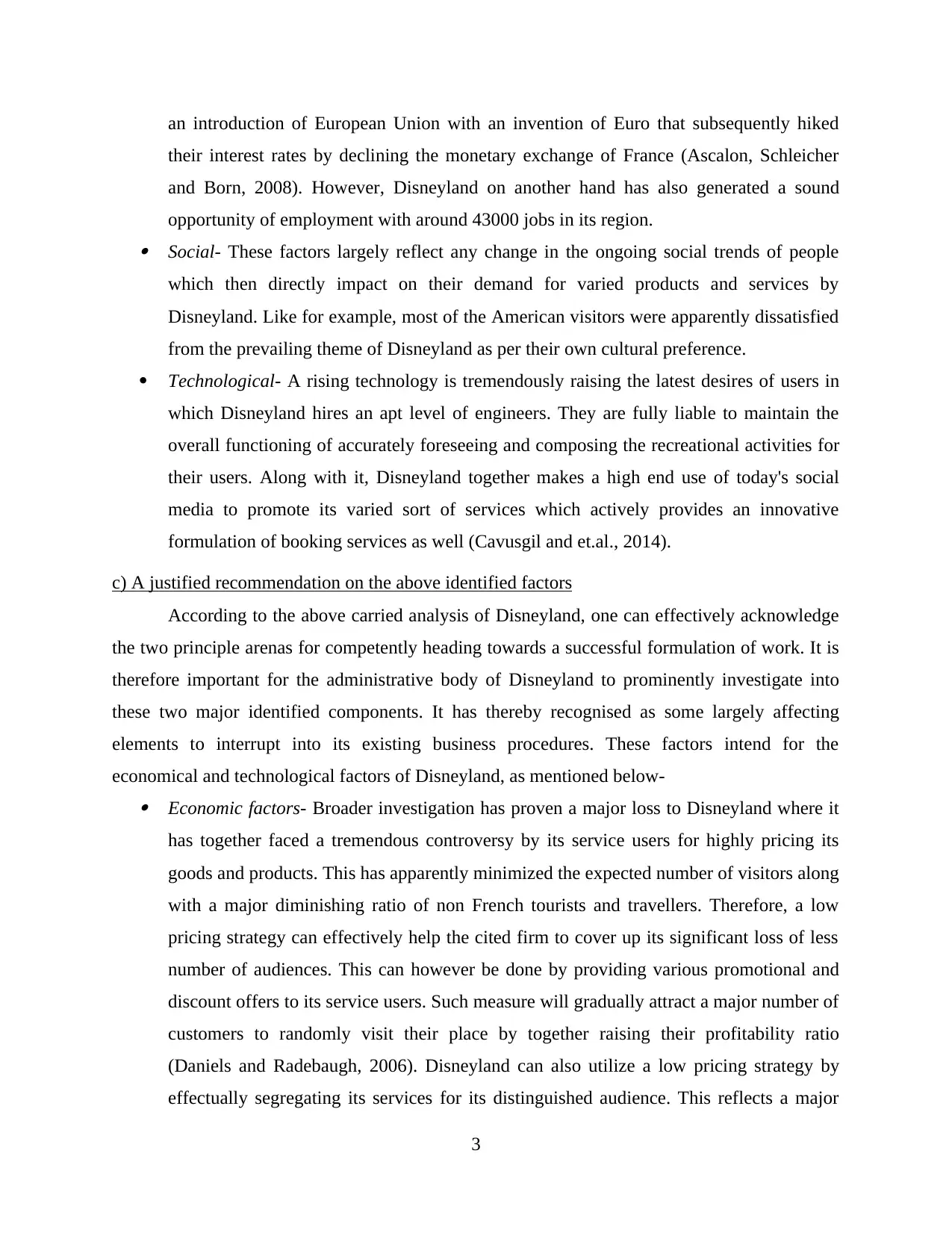
an introduction of European Union with an invention of Euro that subsequently hiked
their interest rates by declining the monetary exchange of France (Ascalon, Schleicher
and Born, 2008). However, Disneyland on another hand has also generated a sound
opportunity of employment with around 43000 jobs in its region. Social- These factors largely reflect any change in the ongoing social trends of people
which then directly impact on their demand for varied products and services by
Disneyland. Like for example, most of the American visitors were apparently dissatisfied
from the prevailing theme of Disneyland as per their own cultural preference.
Technological- A rising technology is tremendously raising the latest desires of users in
which Disneyland hires an apt level of engineers. They are fully liable to maintain the
overall functioning of accurately foreseeing and composing the recreational activities for
their users. Along with it, Disneyland together makes a high end use of today's social
media to promote its varied sort of services which actively provides an innovative
formulation of booking services as well (Cavusgil and et.al., 2014).
c) A justified recommendation on the above identified factors
According to the above carried analysis of Disneyland, one can effectively acknowledge
the two principle arenas for competently heading towards a successful formulation of work. It is
therefore important for the administrative body of Disneyland to prominently investigate into
these two major identified components. It has thereby recognised as some largely affecting
elements to interrupt into its existing business procedures. These factors intend for the
economical and technological factors of Disneyland, as mentioned below- Economic factors- Broader investigation has proven a major loss to Disneyland where it
has together faced a tremendous controversy by its service users for highly pricing its
goods and products. This has apparently minimized the expected number of visitors along
with a major diminishing ratio of non French tourists and travellers. Therefore, a low
pricing strategy can effectively help the cited firm to cover up its significant loss of less
number of audiences. This can however be done by providing various promotional and
discount offers to its service users. Such measure will gradually attract a major number of
customers to randomly visit their place by together raising their profitability ratio
(Daniels and Radebaugh, 2006). Disneyland can also utilize a low pricing strategy by
effectually segregating its services for its distinguished audience. This reflects a major
3
their interest rates by declining the monetary exchange of France (Ascalon, Schleicher
and Born, 2008). However, Disneyland on another hand has also generated a sound
opportunity of employment with around 43000 jobs in its region. Social- These factors largely reflect any change in the ongoing social trends of people
which then directly impact on their demand for varied products and services by
Disneyland. Like for example, most of the American visitors were apparently dissatisfied
from the prevailing theme of Disneyland as per their own cultural preference.
Technological- A rising technology is tremendously raising the latest desires of users in
which Disneyland hires an apt level of engineers. They are fully liable to maintain the
overall functioning of accurately foreseeing and composing the recreational activities for
their users. Along with it, Disneyland together makes a high end use of today's social
media to promote its varied sort of services which actively provides an innovative
formulation of booking services as well (Cavusgil and et.al., 2014).
c) A justified recommendation on the above identified factors
According to the above carried analysis of Disneyland, one can effectively acknowledge
the two principle arenas for competently heading towards a successful formulation of work. It is
therefore important for the administrative body of Disneyland to prominently investigate into
these two major identified components. It has thereby recognised as some largely affecting
elements to interrupt into its existing business procedures. These factors intend for the
economical and technological factors of Disneyland, as mentioned below- Economic factors- Broader investigation has proven a major loss to Disneyland where it
has together faced a tremendous controversy by its service users for highly pricing its
goods and products. This has apparently minimized the expected number of visitors along
with a major diminishing ratio of non French tourists and travellers. Therefore, a low
pricing strategy can effectively help the cited firm to cover up its significant loss of less
number of audiences. This can however be done by providing various promotional and
discount offers to its service users. Such measure will gradually attract a major number of
customers to randomly visit their place by together raising their profitability ratio
(Daniels and Radebaugh, 2006). Disneyland can also utilize a low pricing strategy by
effectually segregating its services for its distinguished audience. This reflects a major
3
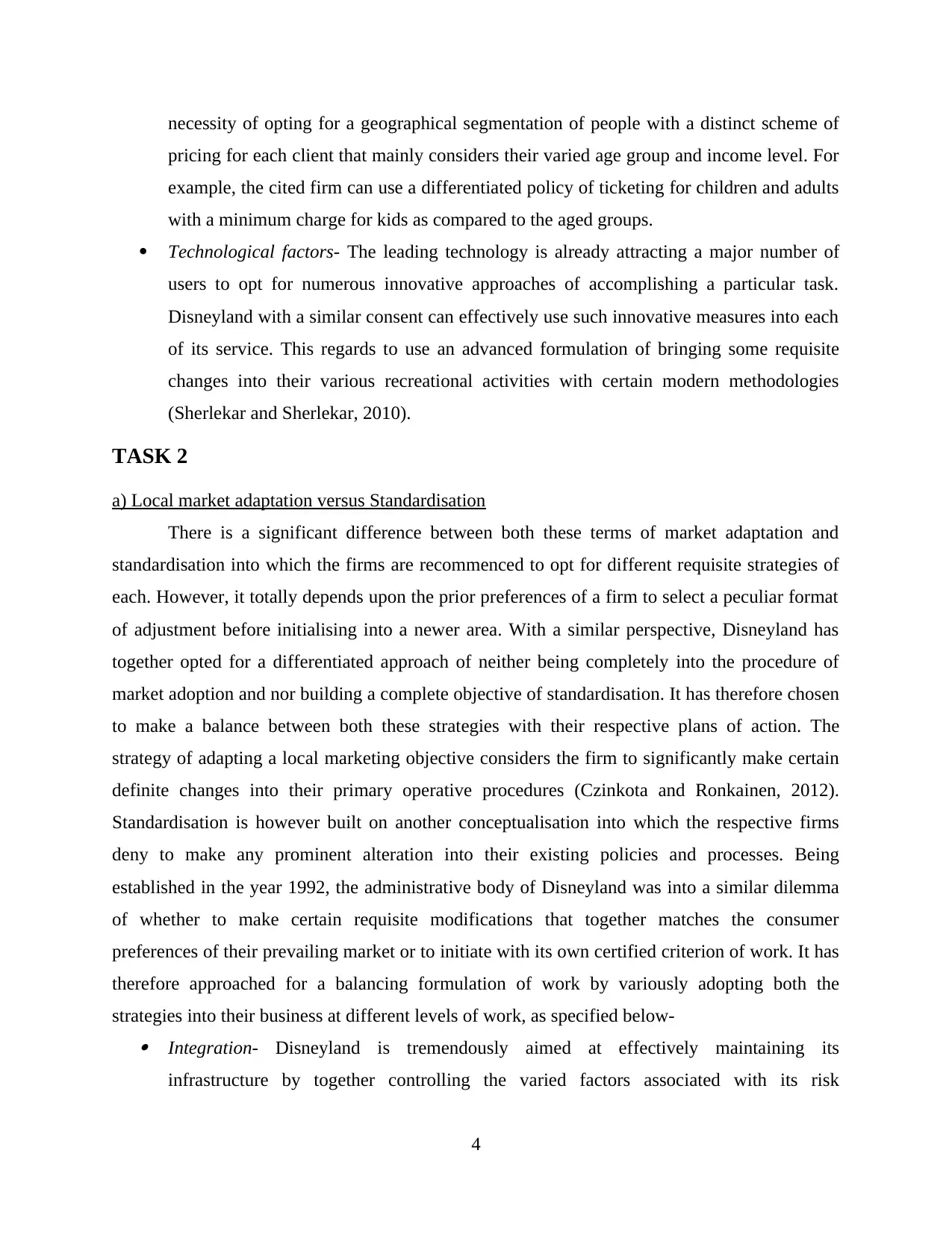
necessity of opting for a geographical segmentation of people with a distinct scheme of
pricing for each client that mainly considers their varied age group and income level. For
example, the cited firm can use a differentiated policy of ticketing for children and adults
with a minimum charge for kids as compared to the aged groups.
Technological factors- The leading technology is already attracting a major number of
users to opt for numerous innovative approaches of accomplishing a particular task.
Disneyland with a similar consent can effectively use such innovative measures into each
of its service. This regards to use an advanced formulation of bringing some requisite
changes into their various recreational activities with certain modern methodologies
(Sherlekar and Sherlekar, 2010).
TASK 2
a) Local market adaptation versus Standardisation
There is a significant difference between both these terms of market adaptation and
standardisation into which the firms are recommenced to opt for different requisite strategies of
each. However, it totally depends upon the prior preferences of a firm to select a peculiar format
of adjustment before initialising into a newer area. With a similar perspective, Disneyland has
together opted for a differentiated approach of neither being completely into the procedure of
market adoption and nor building a complete objective of standardisation. It has therefore chosen
to make a balance between both these strategies with their respective plans of action. The
strategy of adapting a local marketing objective considers the firm to significantly make certain
definite changes into their primary operative procedures (Czinkota and Ronkainen, 2012).
Standardisation is however built on another conceptualisation into which the respective firms
deny to make any prominent alteration into their existing policies and processes. Being
established in the year 1992, the administrative body of Disneyland was into a similar dilemma
of whether to make certain requisite modifications that together matches the consumer
preferences of their prevailing market or to initiate with its own certified criterion of work. It has
therefore approached for a balancing formulation of work by variously adopting both the
strategies into their business at different levels of work, as specified below- Integration- Disneyland is tremendously aimed at effectively maintaining its
infrastructure by together controlling the varied factors associated with its risk
4
pricing for each client that mainly considers their varied age group and income level. For
example, the cited firm can use a differentiated policy of ticketing for children and adults
with a minimum charge for kids as compared to the aged groups.
Technological factors- The leading technology is already attracting a major number of
users to opt for numerous innovative approaches of accomplishing a particular task.
Disneyland with a similar consent can effectively use such innovative measures into each
of its service. This regards to use an advanced formulation of bringing some requisite
changes into their various recreational activities with certain modern methodologies
(Sherlekar and Sherlekar, 2010).
TASK 2
a) Local market adaptation versus Standardisation
There is a significant difference between both these terms of market adaptation and
standardisation into which the firms are recommenced to opt for different requisite strategies of
each. However, it totally depends upon the prior preferences of a firm to select a peculiar format
of adjustment before initialising into a newer area. With a similar perspective, Disneyland has
together opted for a differentiated approach of neither being completely into the procedure of
market adoption and nor building a complete objective of standardisation. It has therefore chosen
to make a balance between both these strategies with their respective plans of action. The
strategy of adapting a local marketing objective considers the firm to significantly make certain
definite changes into their primary operative procedures (Czinkota and Ronkainen, 2012).
Standardisation is however built on another conceptualisation into which the respective firms
deny to make any prominent alteration into their existing policies and processes. Being
established in the year 1992, the administrative body of Disneyland was into a similar dilemma
of whether to make certain requisite modifications that together matches the consumer
preferences of their prevailing market or to initiate with its own certified criterion of work. It has
therefore approached for a balancing formulation of work by variously adopting both the
strategies into their business at different levels of work, as specified below- Integration- Disneyland is tremendously aimed at effectively maintaining its
infrastructure by together controlling the varied factors associated with its risk
4
⊘ This is a preview!⊘
Do you want full access?
Subscribe today to unlock all pages.

Trusted by 1+ million students worldwide
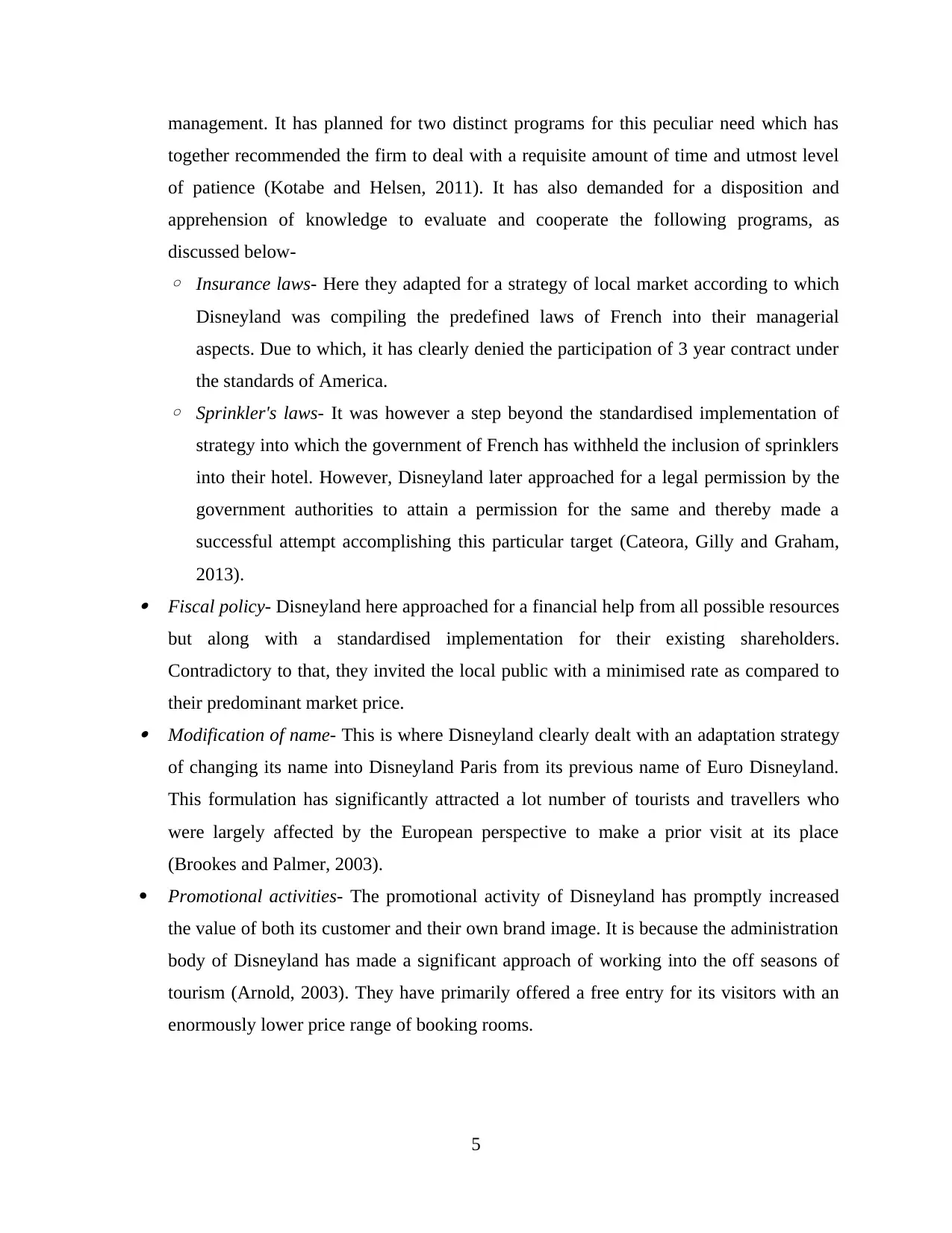
management. It has planned for two distinct programs for this peculiar need which has
together recommended the firm to deal with a requisite amount of time and utmost level
of patience (Kotabe and Helsen, 2011). It has also demanded for a disposition and
apprehension of knowledge to evaluate and cooperate the following programs, as
discussed below-
◦ Insurance laws- Here they adapted for a strategy of local market according to which
Disneyland was compiling the predefined laws of French into their managerial
aspects. Due to which, it has clearly denied the participation of 3 year contract under
the standards of America.
◦ Sprinkler's laws- It was however a step beyond the standardised implementation of
strategy into which the government of French has withheld the inclusion of sprinklers
into their hotel. However, Disneyland later approached for a legal permission by the
government authorities to attain a permission for the same and thereby made a
successful attempt accomplishing this particular target (Cateora, Gilly and Graham,
2013). Fiscal policy- Disneyland here approached for a financial help from all possible resources
but along with a standardised implementation for their existing shareholders.
Contradictory to that, they invited the local public with a minimised rate as compared to
their predominant market price. Modification of name- This is where Disneyland clearly dealt with an adaptation strategy
of changing its name into Disneyland Paris from its previous name of Euro Disneyland.
This formulation has significantly attracted a lot number of tourists and travellers who
were largely affected by the European perspective to make a prior visit at its place
(Brookes and Palmer, 2003).
Promotional activities- The promotional activity of Disneyland has promptly increased
the value of both its customer and their own brand image. It is because the administration
body of Disneyland has made a significant approach of working into the off seasons of
tourism (Arnold, 2003). They have primarily offered a free entry for its visitors with an
enormously lower price range of booking rooms.
5
together recommended the firm to deal with a requisite amount of time and utmost level
of patience (Kotabe and Helsen, 2011). It has also demanded for a disposition and
apprehension of knowledge to evaluate and cooperate the following programs, as
discussed below-
◦ Insurance laws- Here they adapted for a strategy of local market according to which
Disneyland was compiling the predefined laws of French into their managerial
aspects. Due to which, it has clearly denied the participation of 3 year contract under
the standards of America.
◦ Sprinkler's laws- It was however a step beyond the standardised implementation of
strategy into which the government of French has withheld the inclusion of sprinklers
into their hotel. However, Disneyland later approached for a legal permission by the
government authorities to attain a permission for the same and thereby made a
successful attempt accomplishing this particular target (Cateora, Gilly and Graham,
2013). Fiscal policy- Disneyland here approached for a financial help from all possible resources
but along with a standardised implementation for their existing shareholders.
Contradictory to that, they invited the local public with a minimised rate as compared to
their predominant market price. Modification of name- This is where Disneyland clearly dealt with an adaptation strategy
of changing its name into Disneyland Paris from its previous name of Euro Disneyland.
This formulation has significantly attracted a lot number of tourists and travellers who
were largely affected by the European perspective to make a prior visit at its place
(Brookes and Palmer, 2003).
Promotional activities- The promotional activity of Disneyland has promptly increased
the value of both its customer and their own brand image. It is because the administration
body of Disneyland has made a significant approach of working into the off seasons of
tourism (Arnold, 2003). They have primarily offered a free entry for its visitors with an
enormously lower price range of booking rooms.
5
Paraphrase This Document
Need a fresh take? Get an instant paraphrase of this document with our AI Paraphraser
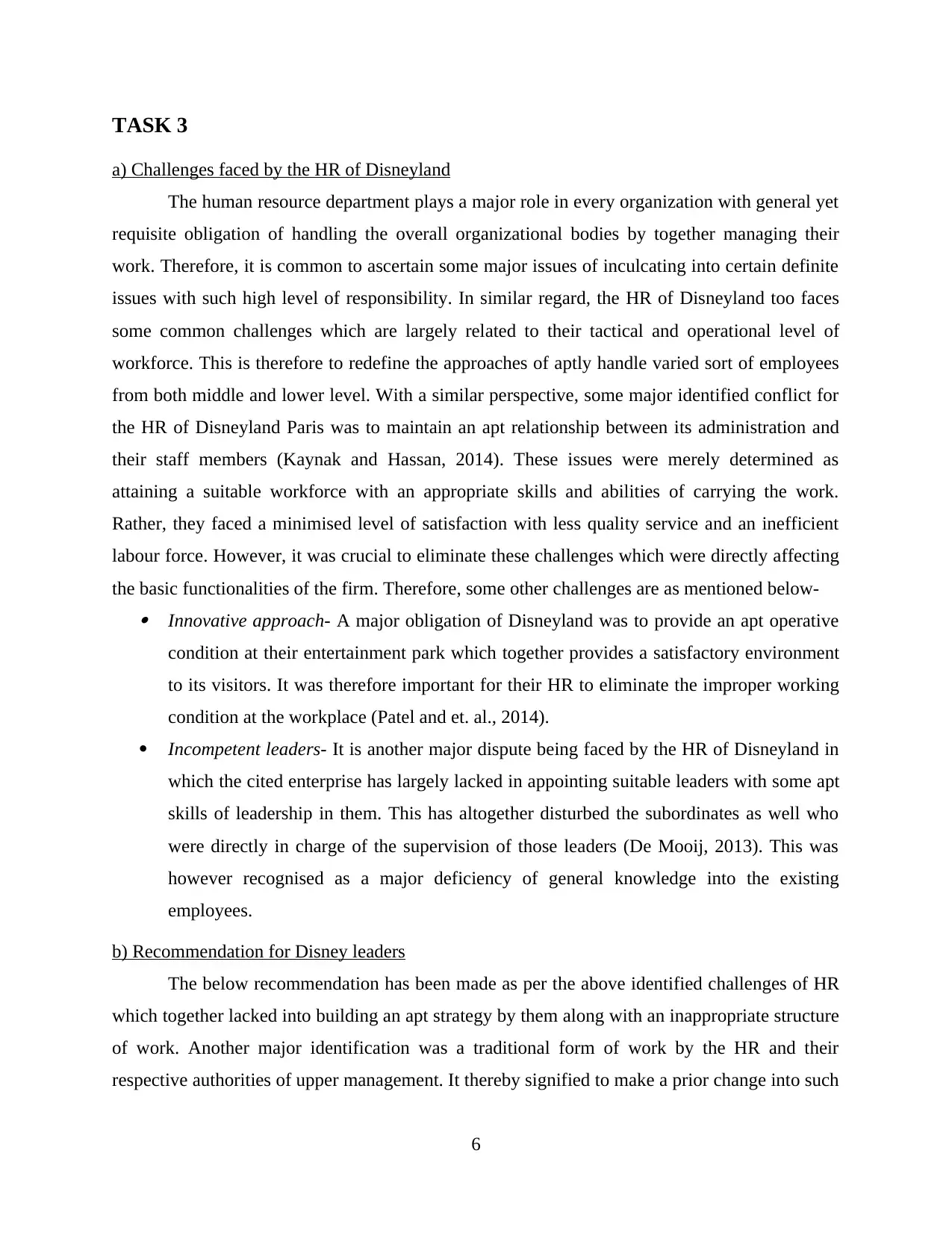
TASK 3
a) Challenges faced by the HR of Disneyland
The human resource department plays a major role in every organization with general yet
requisite obligation of handling the overall organizational bodies by together managing their
work. Therefore, it is common to ascertain some major issues of inculcating into certain definite
issues with such high level of responsibility. In similar regard, the HR of Disneyland too faces
some common challenges which are largely related to their tactical and operational level of
workforce. This is therefore to redefine the approaches of aptly handle varied sort of employees
from both middle and lower level. With a similar perspective, some major identified conflict for
the HR of Disneyland Paris was to maintain an apt relationship between its administration and
their staff members (Kaynak and Hassan, 2014). These issues were merely determined as
attaining a suitable workforce with an appropriate skills and abilities of carrying the work.
Rather, they faced a minimised level of satisfaction with less quality service and an inefficient
labour force. However, it was crucial to eliminate these challenges which were directly affecting
the basic functionalities of the firm. Therefore, some other challenges are as mentioned below- Innovative approach- A major obligation of Disneyland was to provide an apt operative
condition at their entertainment park which together provides a satisfactory environment
to its visitors. It was therefore important for their HR to eliminate the improper working
condition at the workplace (Patel and et. al., 2014).
Incompetent leaders- It is another major dispute being faced by the HR of Disneyland in
which the cited enterprise has largely lacked in appointing suitable leaders with some apt
skills of leadership in them. This has altogether disturbed the subordinates as well who
were directly in charge of the supervision of those leaders (De Mooij, 2013). This was
however recognised as a major deficiency of general knowledge into the existing
employees.
b) Recommendation for Disney leaders
The below recommendation has been made as per the above identified challenges of HR
which together lacked into building an apt strategy by them along with an inappropriate structure
of work. Another major identification was a traditional form of work by the HR and their
respective authorities of upper management. It thereby signified to make a prior change into such
6
a) Challenges faced by the HR of Disneyland
The human resource department plays a major role in every organization with general yet
requisite obligation of handling the overall organizational bodies by together managing their
work. Therefore, it is common to ascertain some major issues of inculcating into certain definite
issues with such high level of responsibility. In similar regard, the HR of Disneyland too faces
some common challenges which are largely related to their tactical and operational level of
workforce. This is therefore to redefine the approaches of aptly handle varied sort of employees
from both middle and lower level. With a similar perspective, some major identified conflict for
the HR of Disneyland Paris was to maintain an apt relationship between its administration and
their staff members (Kaynak and Hassan, 2014). These issues were merely determined as
attaining a suitable workforce with an appropriate skills and abilities of carrying the work.
Rather, they faced a minimised level of satisfaction with less quality service and an inefficient
labour force. However, it was crucial to eliminate these challenges which were directly affecting
the basic functionalities of the firm. Therefore, some other challenges are as mentioned below- Innovative approach- A major obligation of Disneyland was to provide an apt operative
condition at their entertainment park which together provides a satisfactory environment
to its visitors. It was therefore important for their HR to eliminate the improper working
condition at the workplace (Patel and et. al., 2014).
Incompetent leaders- It is another major dispute being faced by the HR of Disneyland in
which the cited enterprise has largely lacked in appointing suitable leaders with some apt
skills of leadership in them. This has altogether disturbed the subordinates as well who
were directly in charge of the supervision of those leaders (De Mooij, 2013). This was
however recognised as a major deficiency of general knowledge into the existing
employees.
b) Recommendation for Disney leaders
The below recommendation has been made as per the above identified challenges of HR
which together lacked into building an apt strategy by them along with an inappropriate structure
of work. Another major identification was a traditional form of work by the HR and their
respective authorities of upper management. It thereby signified to make a prior change into such
6
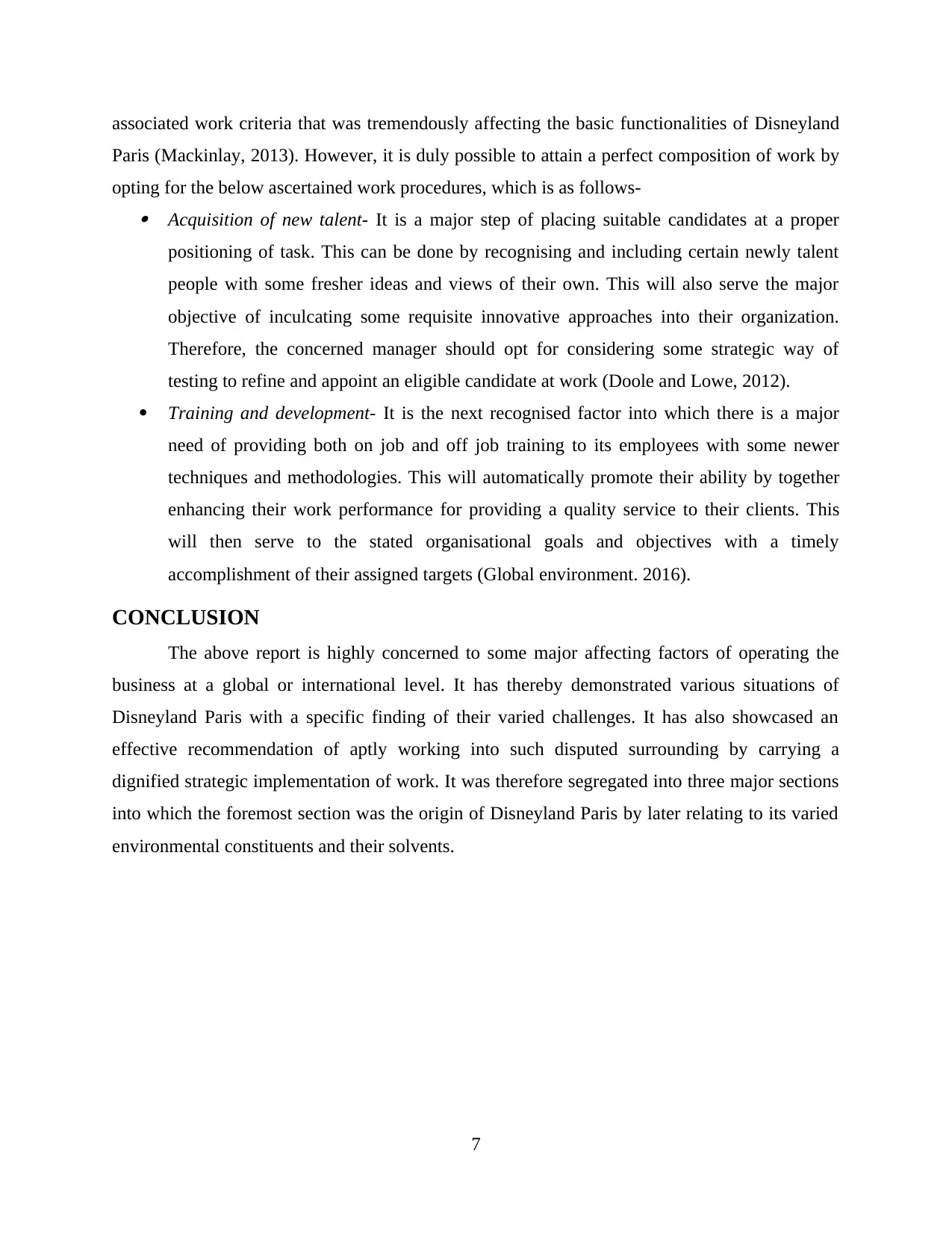
associated work criteria that was tremendously affecting the basic functionalities of Disneyland
Paris (Mackinlay, 2013). However, it is duly possible to attain a perfect composition of work by
opting for the below ascertained work procedures, which is as follows- Acquisition of new talent- It is a major step of placing suitable candidates at a proper
positioning of task. This can be done by recognising and including certain newly talent
people with some fresher ideas and views of their own. This will also serve the major
objective of inculcating some requisite innovative approaches into their organization.
Therefore, the concerned manager should opt for considering some strategic way of
testing to refine and appoint an eligible candidate at work (Doole and Lowe, 2012).
Training and development- It is the next recognised factor into which there is a major
need of providing both on job and off job training to its employees with some newer
techniques and methodologies. This will automatically promote their ability by together
enhancing their work performance for providing a quality service to their clients. This
will then serve to the stated organisational goals and objectives with a timely
accomplishment of their assigned targets (Global environment. 2016).
CONCLUSION
The above report is highly concerned to some major affecting factors of operating the
business at a global or international level. It has thereby demonstrated various situations of
Disneyland Paris with a specific finding of their varied challenges. It has also showcased an
effective recommendation of aptly working into such disputed surrounding by carrying a
dignified strategic implementation of work. It was therefore segregated into three major sections
into which the foremost section was the origin of Disneyland Paris by later relating to its varied
environmental constituents and their solvents.
7
Paris (Mackinlay, 2013). However, it is duly possible to attain a perfect composition of work by
opting for the below ascertained work procedures, which is as follows- Acquisition of new talent- It is a major step of placing suitable candidates at a proper
positioning of task. This can be done by recognising and including certain newly talent
people with some fresher ideas and views of their own. This will also serve the major
objective of inculcating some requisite innovative approaches into their organization.
Therefore, the concerned manager should opt for considering some strategic way of
testing to refine and appoint an eligible candidate at work (Doole and Lowe, 2012).
Training and development- It is the next recognised factor into which there is a major
need of providing both on job and off job training to its employees with some newer
techniques and methodologies. This will automatically promote their ability by together
enhancing their work performance for providing a quality service to their clients. This
will then serve to the stated organisational goals and objectives with a timely
accomplishment of their assigned targets (Global environment. 2016).
CONCLUSION
The above report is highly concerned to some major affecting factors of operating the
business at a global or international level. It has thereby demonstrated various situations of
Disneyland Paris with a specific finding of their varied challenges. It has also showcased an
effective recommendation of aptly working into such disputed surrounding by carrying a
dignified strategic implementation of work. It was therefore segregated into three major sections
into which the foremost section was the origin of Disneyland Paris by later relating to its varied
environmental constituents and their solvents.
7
⊘ This is a preview!⊘
Do you want full access?
Subscribe today to unlock all pages.

Trusted by 1+ million students worldwide
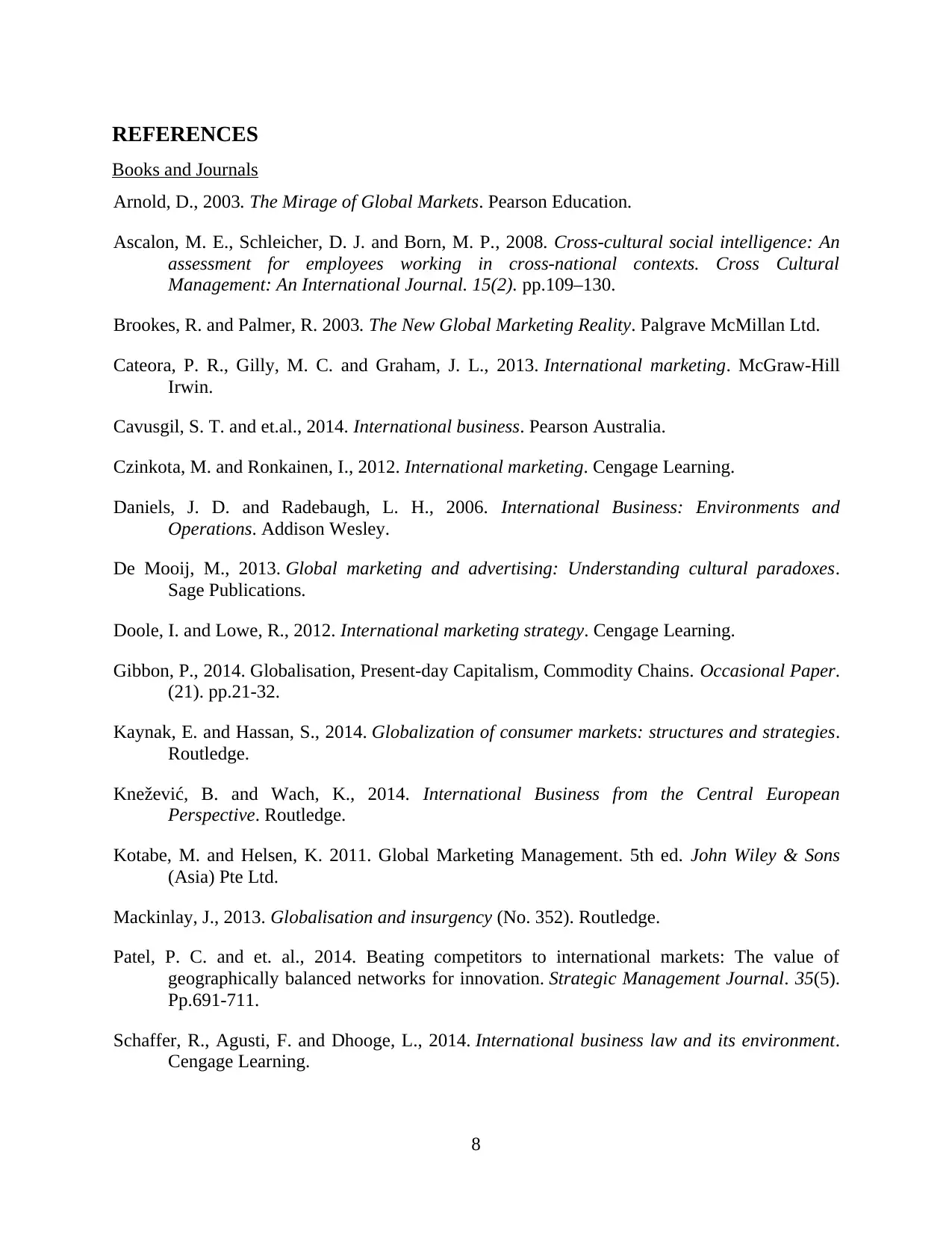
REFERENCES
Books and Journals
Arnold, D., 2003. The Mirage of Global Markets. Pearson Education.
Ascalon, M. E., Schleicher, D. J. and Born, M. P., 2008. Cross-cultural social intelligence: An
assessment for employees working in cross-national contexts. Cross Cultural
Management: An International Journal. 15(2). pp.109–130.
Brookes, R. and Palmer, R. 2003. The New Global Marketing Reality. Palgrave McMillan Ltd.
Cateora, P. R., Gilly, M. C. and Graham, J. L., 2013. International marketing. McGraw-Hill
Irwin.
Cavusgil, S. T. and et.al., 2014. International business. Pearson Australia.
Czinkota, M. and Ronkainen, I., 2012. International marketing. Cengage Learning.
Daniels, J. D. and Radebaugh, L. H., 2006. International Business: Environments and
Operations. Addison Wesley.
De Mooij, M., 2013. Global marketing and advertising: Understanding cultural paradoxes.
Sage Publications.
Doole, I. and Lowe, R., 2012. International marketing strategy. Cengage Learning.
Gibbon, P., 2014. Globalisation, Present-day Capitalism, Commodity Chains. Occasional Paper.
(21). pp.21-32.
Kaynak, E. and Hassan, S., 2014. Globalization of consumer markets: structures and strategies.
Routledge.
Knežević, B. and Wach, K., 2014. International Business from the Central European
Perspective. Routledge.
Kotabe, M. and Helsen, K. 2011. Global Marketing Management. 5th ed. John Wiley & Sons
(Asia) Pte Ltd.
Mackinlay, J., 2013. Globalisation and insurgency (No. 352). Routledge.
Patel, P. C. and et. al., 2014. Beating competitors to international markets: The value of
geographically balanced networks for innovation. Strategic Management Journal. 35(5).
Pp.691-711.
Schaffer, R., Agusti, F. and Dhooge, L., 2014. International business law and its environment.
Cengage Learning.
8
Books and Journals
Arnold, D., 2003. The Mirage of Global Markets. Pearson Education.
Ascalon, M. E., Schleicher, D. J. and Born, M. P., 2008. Cross-cultural social intelligence: An
assessment for employees working in cross-national contexts. Cross Cultural
Management: An International Journal. 15(2). pp.109–130.
Brookes, R. and Palmer, R. 2003. The New Global Marketing Reality. Palgrave McMillan Ltd.
Cateora, P. R., Gilly, M. C. and Graham, J. L., 2013. International marketing. McGraw-Hill
Irwin.
Cavusgil, S. T. and et.al., 2014. International business. Pearson Australia.
Czinkota, M. and Ronkainen, I., 2012. International marketing. Cengage Learning.
Daniels, J. D. and Radebaugh, L. H., 2006. International Business: Environments and
Operations. Addison Wesley.
De Mooij, M., 2013. Global marketing and advertising: Understanding cultural paradoxes.
Sage Publications.
Doole, I. and Lowe, R., 2012. International marketing strategy. Cengage Learning.
Gibbon, P., 2014. Globalisation, Present-day Capitalism, Commodity Chains. Occasional Paper.
(21). pp.21-32.
Kaynak, E. and Hassan, S., 2014. Globalization of consumer markets: structures and strategies.
Routledge.
Knežević, B. and Wach, K., 2014. International Business from the Central European
Perspective. Routledge.
Kotabe, M. and Helsen, K. 2011. Global Marketing Management. 5th ed. John Wiley & Sons
(Asia) Pte Ltd.
Mackinlay, J., 2013. Globalisation and insurgency (No. 352). Routledge.
Patel, P. C. and et. al., 2014. Beating competitors to international markets: The value of
geographically balanced networks for innovation. Strategic Management Journal. 35(5).
Pp.691-711.
Schaffer, R., Agusti, F. and Dhooge, L., 2014. International business law and its environment.
Cengage Learning.
8
Paraphrase This Document
Need a fresh take? Get an instant paraphrase of this document with our AI Paraphraser
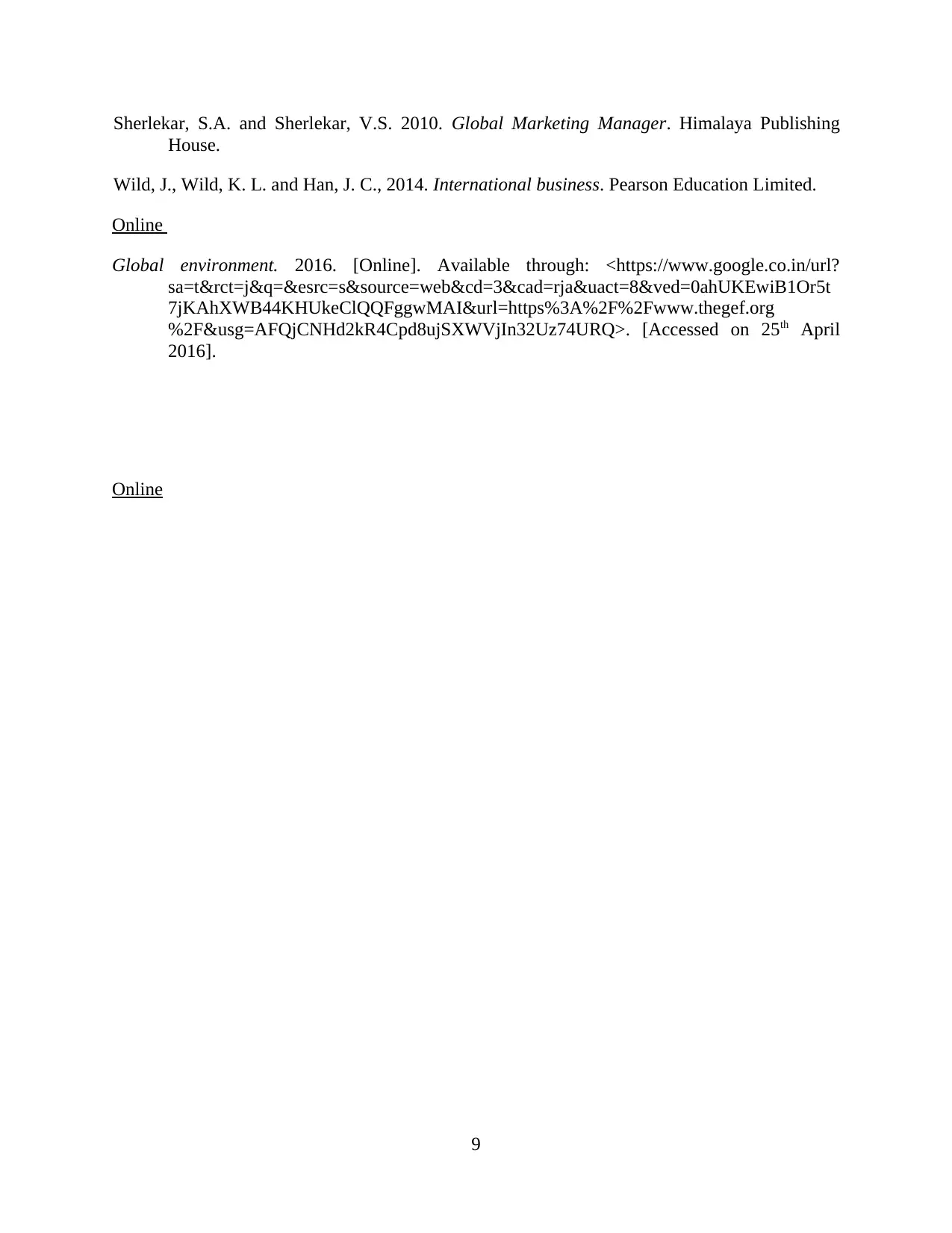
Sherlekar, S.A. and Sherlekar, V.S. 2010. Global Marketing Manager. Himalaya Publishing
House.
Wild, J., Wild, K. L. and Han, J. C., 2014. International business. Pearson Education Limited.
Online
Global environment. 2016. [Online]. Available through: <https://www.google.co.in/url?
sa=t&rct=j&q=&esrc=s&source=web&cd=3&cad=rja&uact=8&ved=0ahUKEwiB1Or5t
7jKAhXWB44KHUkeClQQFggwMAI&url=https%3A%2F%2Fwww.thegef.org
%2F&usg=AFQjCNHd2kR4Cpd8ujSXWVjIn32Uz74URQ>. [Accessed on 25th April
2016].
Online
9
House.
Wild, J., Wild, K. L. and Han, J. C., 2014. International business. Pearson Education Limited.
Online
Global environment. 2016. [Online]. Available through: <https://www.google.co.in/url?
sa=t&rct=j&q=&esrc=s&source=web&cd=3&cad=rja&uact=8&ved=0ahUKEwiB1Or5t
7jKAhXWB44KHUkeClQQFggwMAI&url=https%3A%2F%2Fwww.thegef.org
%2F&usg=AFQjCNHd2kR4Cpd8ujSXWVjIn32Uz74URQ>. [Accessed on 25th April
2016].
Online
9
1 out of 11
Related Documents
Your All-in-One AI-Powered Toolkit for Academic Success.
+13062052269
info@desklib.com
Available 24*7 on WhatsApp / Email
![[object Object]](/_next/static/media/star-bottom.7253800d.svg)
Unlock your academic potential
Copyright © 2020–2025 A2Z Services. All Rights Reserved. Developed and managed by ZUCOL.




